Crater Lake
Crater Lake (Klamath: giiwas)[1] is a crater lake in south-central Oregon in the western United States. It is the main feature of Crater Lake National Park and is famous for its deep blue color and water clarity. The lake partly fills a nearly 2,148-foot-deep (655 m) caldera[2] that was formed around 7,700 (± 150) years ago[3] by the collapse of the volcano Mount Mazama. There are no rivers flowing into or out of the lake; the evaporation is compensated for by rain and snowfall at a rate such that the total amount of water is replaced every 250 years. With a depth of 1,949 feet (594 m),[4] the lake is the deepest in the United States. In the world, it ranks ninth for maximum depth, and third for mean (average) depth.[5]
| Crater Lake | |
|---|---|
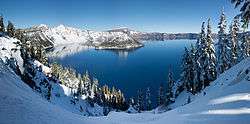 Panoramic winter view of Crater Lake from Rim Village | |
 Crater Lake Location in the United States  Crater Lake Crater Lake (the United States) | |
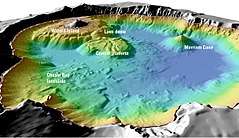 Bathymetric survey | |
| Location | Klamath County, Oregon |
| Coordinates | 42.95°N 122.10°W |
| Lake type | crater lake |
| Primary inflows | precipitation and snowmelt only |
| Primary outflows | evaporation, subsurface seepage to Wood River |
| Catchment area | 23.3 sq mi (60 km2) |
| Basin countries | United States |
| Max. length | 6 mi (9.7 km) |
| Max. width | 5 mi (8.0 km) |
| Surface area | 20.6 sq mi (53 km2) |
| Average depth | 1,148 ft (350 m) |
| Max. depth | 1,943 ft (592 m) |
| Water volume | 4.49 cu mi (18.7 km3) |
| Residence time | 157 years |
| Shore length1 | 21.8 mi (35.1 km) |
| Surface elevation | 6,178 ft (1,883 m) |
| Islands | Wizard Island Phantom Ship |
| 1 Shore length is not a well-defined measure. | |
Crater Lake features two small islands. Wizard Island, located near the western shore of the lake, is a cinder cone approximately 316 acres (128 ha) in size. Phantom Ship, a natural rock pillar, is located near the southern shore.
Since 2002, one of the state's regular-issue license plate designs has featured Crater Lake[6] and a one-time plate surcharge is used to support the operation of Crater Lake National Park.[7] The commemorative Oregon State Quarter, which was released by the United States Mint in 2005, features an image of Crater Lake on its reverse.[8]
The lake and surrounding park areas offer many recreational activities including hiking, biking, snowshoeing, fishing, and cross-country skiing are available, and during the summer, campgrounds and lodges at Crater Lake are open to visitors.
Location
Crater Lake is in Klamath County, approximately 60 miles (97 km) northwest of the county seat of Klamath Falls, and about 80 miles (130 km) northeast of the city of Medford.[9]
In June 1853, John Wesley Hillman became the first non-Native American explorer to report sighting the lake he named the "Deep Blue Lake." The lake was renamed at least three times, as Blue Lake, Lake Majesty, and finally Crater Lake.[10][11]

Dimensions and depth
The lake is 5 by 6 miles (8.0 by 9.7 km) across, with a caldera rim ranging in elevation from 7,000 to 8,000 feet (2,100 to 2,400 m) and an average lake depth of 1,148 feet (350 m). The lake's maximum depth has been measured at 1,949 feet (594 m),[2][4][12][13] which fluctuates slightly as the weather changes.[2] On the basis of maximum depth, Crater Lake is the deepest lake in the United States, the second-deepest in North America (after Great Slave Lake in Canada), and the ninth-deepest lake in the world.[14] Crater Lake is often cited as the seventh-deepest lake in the world, but this ranking excludes Lake Vostok in Antarctica,[15][16] which is beneath about 13,000 feet (4,000 m) of ice, and the recent depth soundings of O'Higgins/San Martín Lake, which is along the border of Chile and Argentina.[17]
When considering the mean, or average depth of lakes, Crater Lake becomes the deepest lake in the Western Hemisphere and the third-deepest in the world. Crater Lake Institute Director and limnologist Owen Hoffman states "Crater Lake is the deepest, when compared on the basis of average depth among lakes whose basins are entirely above sea level. The average depths of Lakes Baikal and Tanganyika are deeper than Crater Lake; however, both have basins that extend below sea level."[16][18]
Geology
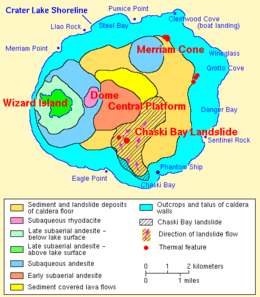
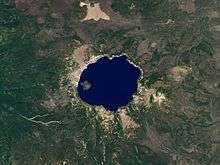
Mount Mazama, part of the Cascade Range volcanic arc, was built up mostly of andesite, dacite, and rhyodacite over a period of at least 400,000 years. The caldera was created in a massive volcanic eruption between 6,000 and 8,000 years ago that led to the subsidence of Mount Mazama. About 12 cubic miles (50 km3) of rhyodacite was erupted in this event. Since that time, all eruptions on Mazama have been confined to the caldera.[19][20]
Lava eruptions later created a central platform, Wizard Island, Merriam Cone, and other, smaller volcanic features, including a rhyodacite dome that was eventually created atop the central platform. Sediments and landslide debris also covered the caldera floor.[21]
Eventually, the caldera cooled, allowing rain and snow to accumulate and form a lake. Landslides from the caldera rim thereafter formed debris fans and turbidite sediments on the lake bed. Fumaroles and hot springs remained common and active during this period. Also after some time, the slopes of the lake's caldera rim more or less stabilized, streams restored a radial drainage pattern on the mountain, and dense forests began to revegetate the barren landscape. It is estimated that about 720 years was required to fill the lake to its present depth of 1,949 feet (594 m). Much of this occurred during a period when the prevailing climate was less moist than at present.[22]
Some hydrothermal activity remains along the lake floor, suggesting that at some time in the future, Mazama may erupt once again.[23]
In 2008, scientists submerged a robot into the lake to collect more geological information to compare to the data obtained in the 1980s.[24] The scientists hypothesized that the moss was about 6,000 years old by measuring the age of pollen that blew into the lake and mixed with the sediment.[24]
Climate
Crater Lake features a subalpine climate, with the rare dry-summer type (Köppen classification Dsc) owing to its high elevation and – like all of Oregon – the strong summer influence of the North Pacific High. In the summer, the weather is mild and dry, but in the winter is cold and the powerful influence of the Aleutian Low allows for enormous snowfalls averaging 505 inches (12.83 m) per year and maximum snow cover averaging 139 in or 3.53 m. This snow does not usually melt until mid-July, and allows for substantial glaciers on adjacent mountains. In the winter of 1949/1950 as much as 885.1 inches (22.48 m) of snow fell, while the less complete snow cover records show cover as high as 192 in or 4.88 m occurred during another particularly unsettled winter in 1981/1982.[25] The heaviest daily snowfall was 37.0 inches (94.0 cm), which occurred as recently as February 28, 1971; 20 in (51 cm) or more in one storm has occurred in both June and September. Hard frost is possible even into the summer, and the average window for freezing temperatures is August 19 through July 7, while for measurable (≥0.1 in or 0.25 cm) snowfall, October 1 through June 15. Surface temperatures of the lake range between 33 °F (1 °C) and 66 °F (19 °C).[26] In the summer, the lake temperature falls between 50 °F (10 °C) and 60 °F (16 °C).[26]
| Climate data for Crater Lake | |||||||||||||
|---|---|---|---|---|---|---|---|---|---|---|---|---|---|
| Month | Jan | Feb | Mar | Apr | May | Jun | Jul | Aug | Sep | Oct | Nov | Dec | Year |
| Record high °F (°C) | 64 (18) |
66 (19) |
67 (19) |
71 (22) |
80 (27) |
95 (35) |
100 (38) |
94 (34) |
93 (34) |
81 (27) |
71 (22) |
64 (18) |
100 (38) |
| Average high °F (°C) | 33.8 (1.0) |
35.2 (1.8) |
37.3 (2.9) |
42.8 (6.0) |
50.5 (10.3) |
58.6 (14.8) |
69.6 (20.9) |
69.6 (20.9) |
63.0 (17.2) |
52.0 (11.1) |
40.1 (4.5) |
34.6 (1.4) |
48.9 (9.4) |
| Daily mean °F (°C) | 25.8 (−3.4) |
26.8 (−2.9) |
28.3 (−2.1) |
32.6 (0.3) |
39.4 (4.1) |
46.3 (7.9) |
55.2 (12.9) |
55.1 (12.8) |
49.7 (9.8) |
41.2 (5.1) |
31.8 (−0.1) |
26.8 (−2.9) |
38.3 (3.5) |
| Average low °F (°C) | 17.7 (−7.9) |
18.3 (−7.6) |
19.2 (−7.1) |
22.3 (−5.4) |
28.2 (−2.1) |
33.9 (1.1) |
40.7 (4.8) |
40.6 (4.8) |
36.3 (2.4) |
30.3 (−0.9) |
23.4 (−4.8) |
19.0 (−7.2) |
27.5 (−2.5) |
| Record low °F (°C) | −21 (−29) |
−18 (−28) |
−7 (−22) |
−3 (−19) |
5 (−15) |
10 (−12) |
18 (−8) |
23 (−5) |
16 (−9) |
3 (−16) |
−7 (−22) |
−18 (−28) |
−21 (−29) |
| Average precipitation inches (mm) | 10.20 (259) |
7.93 (201) |
7.74 (197) |
4.96 (126) |
3.22 (82) |
2.31 (59) |
0.75 (19) |
0.95 (24) |
2.08 (53) |
1.94 (49) |
9.25 (235) |
11.14 (283) |
62.47 (1,587) |
| Average snowfall inches (cm) | 96.2 (244) |
82.0 (208) |
82.2 (209) |
45.3 (115) |
19.7 (50) |
3.9 (9.9) |
0.2 (0.51) |
0.1 (0.25) |
2.8 (7.1) |
21.4 (54) |
60.8 (154) |
90.4 (230) |
505 (1,281.76) |
| Average rainy days | 18.0 | 15.9 | 18.2 | 15.5 | 11.2 | 8.0 | 3.9 | 4.0 | 5.8 | 9.8 | 17.5 | 18.1 | 145.9 |
| Average snowy days | 15.9 | 14.3 | 15.6 | 12.2 | 5.9 | 2.0 | 0.1 | 0.0 | 1.0 | 4.7 | 13.2 | 16.4 | 101.3 |
| Mean monthly sunshine hours | 124.0 | 141.3 | 217.0 | 240.0 | 310.0 | 330.0 | 372.0 | 341.0 | 270.0 | 217.0 | 90.0 | 93.0 | 2,745.3 |
| Percent possible sunshine | 44 | 45 | 58 | 62 | 67 | 73 | 80 | 79 | 75 | 64 | 30 | 33 | 59 |
| Average ultraviolet index | 2 | 2 | 4 | 6 | 8 | 9 | 9 | 8 | 6 | 4 | 2 | 1 | 5 |
| Source 1: Western Regional Climate Center[27] | |||||||||||||
| Source 2: Weather Atlas [28] (sunshine data, UV index) | |||||||||||||
Ecology
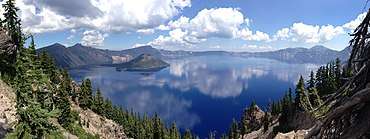
Since the collapse of Mount Mazama due to a volcanic eruption formed Crater Lake, no fish inhabited the lake until William G. Steel decided to stock it in 1888 to allow for fishing.[29] Regular stocking continued until 1941, when it was evident that the fish could maintain a stable population without outside interference. Six species of fish were originally stocked, but only two species have survived: Kokanee Salmon and Rainbow Trout with Kokanee being the most plentiful.[29] Fishing in Crater Lake is promoted because the fish species are not indigenous to the lake.[26]
Crater Lake is also known for the "Old Man of the Lake", a full-sized tree which is now a log that has been bobbing vertically in the lake for over a century.[30][31] The low temperature of the water has slowed the decomposition of the wood, hence its longevity.
In 1987, scientists sent a submersible down to the depths of Crater Lake to obtain more information about the geology at the bottom of the lake,[32] and inspect moss samples found in moss beds as deep as 600 feet (180 m).[24]
Due to several unique factors, mainly that the lake has no inlets or tributaries, the waters of Crater Lake are some of the purest in the world because of the absence of pollutants. Clarity readings from a Secchi disk have consistently been measured as being 120 ft (37 m), which is very clear for any natural body of water. In 1997, scientists recorded a record clarity of 142 ft (43 m).
The lake has relatively high levels of dissolved salts, total alkalinity, and conductivity. The average pH has generally ranged between 7 and 8.[33]
Sacred significance
.jpg)
The Klamath tribe of Native Americans, whose oral history describes their ancestors witnessing the collapse of Mount Mazama and the formation of Crater Lake, regard the lake as an "abode to the Great Spirit".[34] Klamath oral history tells of a battle between the sky god Skell and the god of the underworld Llao (a prominent feature at Crater Lake is Llao Rock). Mount Mazama was destroyed in the battle, creating Crater Lake, called giiwas in the Klamath language.[1] The Klamath people used Crater Lake in vision quests, which often involved climbing the caldera walls and other dangerous tasks. Those who were successful in such quests were often regarded as having more spiritual powers. The tribe still holds Crater Lake in high regard as a spiritual site.[35][36]
Recreation
Located 56 miles (90 km) north of the city of Klamath Falls and 62 miles (100 km) northeast of Medford, Crater Lake can be reached from U.S. Route 97 on the east, on the southwest by Highway 62, and on the northwest by Highway 138.[37] Crater Lake and the remnants of Mount Mazama can be seen from Rim Drive, a 33-mile (53 km) road that surrounds the caldera,[38] which is the only part within the Crater Lake National Park where vehicles are permitted.[37] The Garfield Peak Trail, which runs 1.5 miles (2.4 km) east from the Crater Lake Lodge, offers views from 1,900 feet (580 m) above the lake's surface, with Mount Shasta visible 125 miles (201 km) southward. Another trail runs for 2.5 miles (4.0 km) from Rim Drive's eastern edge to Mount Scott, which offers views of central and southern Oregon such as the Three Sisters located 80 miles (130 km) north of Mazama and Mount Thielsen, also to the north. The Cleetwood trail leads for 1 mile (1.6 km) down the northern flank of the caldera rim, eventually reaching Cleetwood Cove where boat trips run from late June or early July throughout the summer season to Wizard Island.[39] Wizard Island can be climbed, offering views of Crater Lake.[38]
Swimming is permitted in Crater Lake, but the only way to safely and legally get to the shore is by following Cleetwood Cove trail and people can enter the water from there.[40] Other activities include fishing and a 2-hour boat tour around the lake provided by a Park Ranger from Crater Lake National Park.[41]
As the region lies within a national park area, collecting rocks within the vicinity is prohibited unless a permit is obtained.[42] The park's facilities lie at Rim Village, at the southern edge of the caldera.[37] Lodging and camping facilities open during the summer season between May and October.[43] No lodges, gas stations, or camping areas remain open from October through late May.[44] Popular activities within Crater Lake National Park include biking,[45] fishing,[46] cross-country skiing, and snowshoeing.[47]
See also
- List of lakes in Oregon
- Volcanic Legacy Scenic Byway
Notes
- "Klamath Tribes Language Project". The Klamath Tribes. 2012. Retrieved March 21, 2016.
- "Facts about Crater Lake". Oregon Explorer. Oregon State University. Retrieved February 5, 2009.
- "Crater Lake". Global Volcanism Program. Smithsonian Institution. Retrieved December 18, 2008.
- Bacon, CR; Gardner, JV; Mayer, LA; Buktnenica, MW; et al. (June 2002). "Morphology, volcanism, and mass wasting in Crater Lake, Oregon" (PDF). GSA Bulletin. 114 (6): 675–692. Bibcode:2002GSAB..114..675B. doi:10.1130/0016-7606(2002)114<0675:mvamwi>2.0.co;2.
- See further details in the prose and citations of #Dimensions and depth.
- Goetze, Janet (August 26, 2002). "Crater Lake plates aglow with color". The Oregonian. Portland, Oregon. p. B4.
- Killen, John. "Oregon license plates: Something for just about everyone". The Oregonian. Portland, Oregon.
- "The Oregon Quarter: The United States Mint". U.S. Department of the Treasury. Archived from the original on September 27, 2009. Retrieved June 29, 2007.
- "Crater Lake National Park: Directions". National Park Service. Retrieved December 10, 2009.
- Tilden, Freeman (1968). The National Parks. New York: Alfred A. Knopf.
- Runkel, H.J. (1953). "Crater Lake Discovery Centennial". Nature Notes from Crater Lake National Park. XIX. Archived from the original on December 4, 2008.
- Andalkar, Amar (December 18, 2003). "Crater Lake (Mount Mazama)". Skiing the Cascade Volcanoes. skimountaineer.com. Retrieved July 8, 2013.
- Gibbons, Helen (September 2000). "CMG Maps Bottom of Crater Lake, Oregon". U.S. Geological Survey. Retrieved May 16, 2010.
- Noah Tesch. "9 of the World's Deepest Lakes". Encyclopaedia Britannica. Archived from the original on April 8, 2017. Retrieved May 8, 2017.
#9 Crater Lake (1,943 feet [592 meters]), #8 Great Slave Lake (2,015 feet [614 meters])
- Evans, C.T. (2007). "Lake Baikal". Northern Virginia Community College. Retrieved July 8, 2013.
- Juillerat, Lee (November 29, 2007). "Into the Deep: Crater Lake's ranking as one of the world's deepest lakes varies by how list is determined". Herald and News. Klamath Falls, Oregon. Archived from the original on August 17, 2014. Retrieved July 8, 2013.
- Jaros, Garret (March 16, 2010). "A snowshoe view: Take a ranger-guided winter trek around snowy Crater Lake" (Oregon Life section). The Register-Guard. Eugene, Oregon. p. D1. Retrieved July 8, 2013.
- Repanshek, Kurt; Hoffman, Owen (November 14, 2007). "Crater Lake, On Average, Is Deepest Lake in North America" (see story comments as well). National Parks Traveler. Retrieved July 8, 2013.
- Topinka, Lyn (April 18, 2008). "Mount Mazama Volcano and Crater Lake Caldera, Oregon". Cascades Volcano Observatory. U.S. Geological Survey. Retrieved July 8, 2013.
- Jewell and McRae, p. 571
- Bacon, Charles R; James V. Gardner; Larry A. Mayer; Mark W. Buktenica; Peter Dartnell; David W. Ramsey; Joel E. Robinson (2002). "Morphology, volcanism, and mass wasting in Crater Lake, Oregon". Geological Society of America Bulletin. 114 (6): 675–692. Bibcode:2002GSAB..114..675B. doi:10.1130/0016-7606(2002)114<0675:MVAMWI>2.0.CO;2.
- Nathenson, Manuel; Charles R. Bacon; David W. Ramsey (2007). "Subaqueous geology and a filling model for Crater Lake, Oregon". Hydrobiologia. 574: 13–27. doi:10.1007/s10750-006-0343-5.
- "Geologic History of Crater Lake". Oregon Explorer. Oregon State University. Retrieved February 5, 2009.
- Olsen, Stefanie. "Diving into mysterious Crater Lake". CNET. Retrieved March 10, 2019.
- National Oceanic and Atmospheric Administration; Climate at a Glance: Oregon Climate Division 5 (High Plateau) October to June Precipitation
- Lake, Mailing Address: Crater Lake National Park PO Box 7 Crater; Us, OR 97604 Phone:594-3000 Contact. "Frequently Asked Questions – Crater Lake National Park (U.S. National Park Service)". www.nps.gov. Retrieved March 10, 2019.
- "CRATER LAKE NPS HQ, OREGON (351946)". Western Regional Climate Center. Retrieved June 12, 2016.
- "Crater Lake, Oregon, USA – Monthly weather forecast and Climate data". Weather Atlas. Retrieved June 14, 2019.
- "Fish of Crater Lake National Park". www.craterlakeinstitute.com. Archived from the original on July 15, 2018. Retrieved March 10, 2019.
- Kartchnerand, W.E.; Doerr, J.E., Jr. (September 1938). "Wind Currents In Crater Lake As Revealed By The Old Man Of The Lake". Nature Notes from Crater Lake National Park. XI (3). Archived from the original on June 11, 2008.
- "On the Trail The Old man of Crater Lake" (Video). CBS News. October 9, 2016. Retrieved October 9, 2016.
- Lake, Mailing Address: Crater Lake National Park PO Box 7 Crater; Us, OR 97604 Phone:594-3000 Contact. "Underwater exploration in Crater Lake – Crater Lake National Park (U.S. National Park Service)". www.nps.gov. Retrieved March 10, 2019.
- "Facts and Figures about Crater Lake" (PDF). U.S. National Park Service. Archived from the original (PDF) on September 28, 2013. Retrieved January 3, 2012.
- Diller, J.S. (1898). Crater Lake, Oregon
- "Park History" (PDF). National Park Service. Archived from the original (PDF) on April 15, 2013. Retrieved January 3, 2012.
- "Crater Lake as Sacred Site". Sacred Destinations. Archived from the original on June 2, 2009.
- Bacon 2008, p. 1.
- Harris 2005, pp. 155–156.
- Harris 2005, p. 155.
- "Frequently Asked Questions". Crater Lake National Park. U.S. National Park Service. Retrieved March 11, 2019.
- "Top 6 Must-Dos at Crater Lake National Park". Travel Heals. February 11, 2015. Retrieved March 11, 2019.
- Geist, Wolff & Harpp 2017, p. 19.
- "Lodging & Camping (Summer)" (PDF). National Park Service. October 2017. Retrieved May 24, 2018.
- "Lodging & Camping (Winter)" (PDF). National Park Service. October 2017. Retrieved May 24, 2018.
- "Crater Lake: Bicycling" (PDF). National Park Service. July 2012. Retrieved May 24, 2018.
- "Crater Lake: Fishing" (PDF). National Park Service. February 2010. Retrieved May 24, 2018.
- "Crater Lake: cross-Country Ski and Snowshoe Rentals" (PDF). National Park Service. October 2017. Retrieved May 24, 2018.
References
- Fire Mountains of the West: The Cascade and Mono Lake Volcanoes, Stephen L. Harris, (Mountain Press Publishing Company, Missoula; 1988) ISBN 0-87842-220-X
- Geology of National Parks: Fifth Edition, Ann G. Harris, Esther Tuttle, Sherwood D. Tuttle, (Iowa, Kendall/Hunt Publishing; 1997) ISBN 0-7872-5353-7
- Bacon, Charles R.; Lanphere, Marvin A. (2006). "Eruptive history and geochronology of Mount Mazama and the Crater Lake region, Oregon". Geological Society of America Bulletin. 118 (11–12): 1331–1359. Bibcode:2006GSAB..118.1331B. doi:10.1130/B25906.1.
- Oregon, Moon Handbooks, Judy Jewell, W. C. McRae, (Avalon Travel, Berkeley; 2012, 9th edition) ISBN 978-1-59880-885-8
External links
| Wikimedia Commons has media related to Crater Lake. |